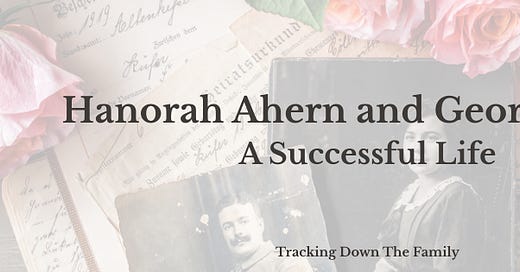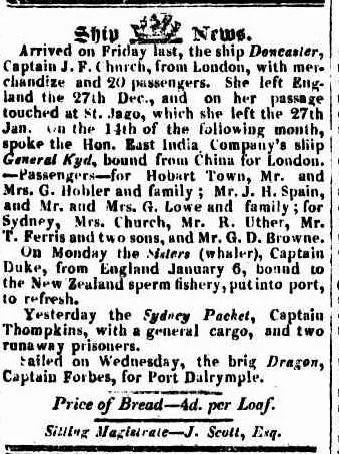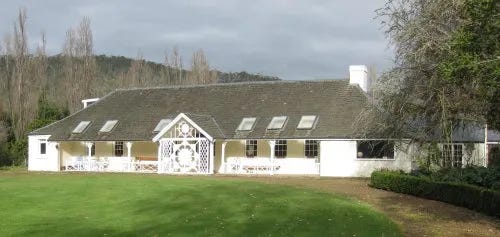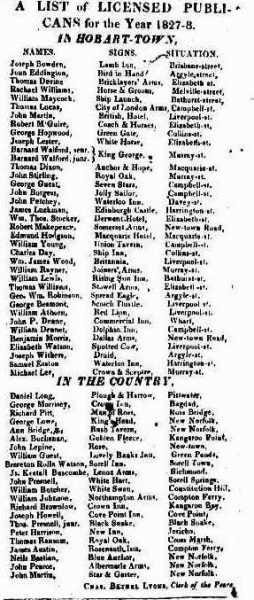Hanorah Ahern and George Lowe: A Successful Life. Day 2 50 Day Family History Blogging Challenge
Convict Series Part 4
Hanorah Ahern was my 4x great grandmother and my convict ancestor. This is the fourth in the series about my convict ancestors. Before reading this, it would be best to catch up with the story of Hanorah, and how she came to be transported to Australia, serve her term and receive her ticket of freedom. We pick up Hanorah’s story as she is about to be married.
If you missed the first three parts of this series, the links are below:
Do You have a Convict in Your Family: Convict Series Part 1
The Female Convict in Our Family: Hanorah Ahern Convict Series Part 2
Hanorah Ahern: Convict Rags to Riches Convict Series Part 3
In the previous episode of this convict series, Hanorah Ahern’s life was starting to look up after her marriage to George Lowe. George had been transported to Australia in 1803 for stealing. He was emancipated in 1813. By the time he and Hanorah were married, he had become a respectable, wealthy businessman, having acquired a large amount of property, in and around Hobart.11
A Successful Life
1815
In July 1815, George paid pounds £120 to James Bryan Cullen for 78 acres of land, situated on the Derwent River in the district of New Norfolk.
1816
Just a few months later, in January 1816, George Lowe successfully tendered to supply 1500 lbs of fresh meat to His Majesty’s Magazine on 28 March 1817.
1823
George and Hanorah were planning a trip back to England and perhaps Ireland. It was not usual for convicts to return to their home country after they were emancipated. George owned a house that he sold, possibly to get funds for the trip.
from: Hobart Town Gazette, 10 May 18232
To New Settlers & others,- To be disposed of by Private Contract, those valuable and extensive Premises, situate at the corner of Liverpool and Argyle-streets, in the central part of Hobart Town, consisting of a good shop in full trade, parlour, bed-room, kitchen, with a cellar under it, and an excellent 5-stall stable with a loft above, which will hold 1000 bushels of wheat; also, a substantial bakehouse ad joining, with bed-room, &c. - As the proprietor is about to proceed to England, he requests all claims against him may be presented; and all persons indebted to him are requested to pay the same forthwith. Apply to the proprietor, George Lowe, on the Premises.
1824
George and Norah left Hobart, bound for England on the SS Denmark Hill on 29 December 1824. The trip was partly for pleasure, possibly to visit family in England and/or Ireland, but it was also a business trip. They were away for seventeen months. Their 5th child, Caroline, was born in England. It appears they didn’t take their two children, as the excerpt from a newspaper report, below, shows.
1826 The Lowes Return Home
From: The Colonial Times and Tasmanian Advertiser, Friday 12 May 1826, page 2.
SHIP NEWS
Arrived on Friday last, the ship Doncaster, Captain J.F. Church, from London, with merchandize and 20 passengers. She left England the 27th Dec, and on her passage touched at St. Jago, which she left the 27th Jan. On the 14th of the following month, spoke the Hon. East India Company’s ship General Kyd, bound from China for London. -Passengers for Hobart Town, Mr. and Mrs. G. Hobler and family ; Mr. J. H. Spain, and Mr. and Mrs. G. Lowe and family; for Sydney, Mrs. Church, Mr. R. Uther, Mr. T. Ferris and two sons, and Mr. G. D. Browne.
1826
Within days of returning to Hobart, George was back in business, advertising a vast amount and variety of imported goods for sale:
from: The Colonial Times and Tasmanian Advertiser, 12 May 1826
Mr. George Lowe takes, this opportunity of informing his Friends and the Public, that he has returned from England by the ship Doncaster, and has for SALE at his Stores, in Argyle-street, the following Goods:-Company's pieces of nankeen, fine calico and shirting, warranted blue prints, bed-ticking of different qualities, black and coloured bombasine, Norwich crapes, shawl handkerchiefs, coloured thread, super cambrics, tine striped cotton shirts, smock frocks, swansdown waistcoats, watermen's trowsers drab jean and plush cord ditto, fustain and velveteen dresses for children, a great variety of mens' jackets, waistcoats, and trowsers boy's nap wrappers scales of various sizes mould and dipt candles, soap in boxes, pint and quart decanters, goblets and tumblers of sizes, wine glasses; a very extensive assortment of hosiery, consisting of men, women and children's cotton and worsted stockings of every description, and of the very best quality; stout worsted waistcoats, patent fancy cravats for travelling, worsted caps, slik and cotton braces, gloves, fleecy boots, blue breakfast cups and saucers, dinner, pie and soup plates; baking dishes, Cape Madeira wine in casks, rum in puncheons, sewing twine in balls, shoemaker's thread, Turkey raisins, currants, fig blue, ginger, spices English molasses, pickles in pint bottles, English silk baud kerchiefs, raven grey sewing silk, two 8 day convex spring dials, vinegar in casks, double Gloucester und Dutch cheese, tobacco pipes, fancy beaver and, satin hats, trimmed with feathers; gentlemen's best water-proof hats, boy's drab and green hats, flannel of various qualities, black twill and bombaset; grey, check, green, and red plaid; drab cord for trowsers, prime Irish butter, blacking; quart, pint, and half-pint pewter pots; mugs, frame saw tiles, 3- bushel sacks, copper tea kettles; net caps, collars, and tippets; a handsome net dress, net shawls and scarfs, sprig and plain muslin caps, bed furniture; cricket balls, boy's strong half-boots, children's coloured ditto, ladies shoes, womens and children's stays; pictures in frames, fishing hooks of various sizes, constables' pocket staffs, mustard, and a great variety of other goods.
17 August 1827
from: Colonial Times and Tasmanian Advertiser (Hobart, Tas: 1825-1827), Friday 17 August, page 1
Mr. G. LOWE begs to return his acknowledgments for the Favours he has received since he recommenced Business in Hobart Town; and takes this opportunity of informing his Friends and the Public, that he is about removing to the King's Head Inn, at New Norfolk; where, in addition to the Public House Business, it is his intention to open a Store, for the Sale of all kinds of Goods, at the lowest Price for ready Money, or Credit on good Security.
24 August 1827
Store Opening
Mr. GEORGE LOWE, a wealthy trader of Hobart Town, is about to open an establishment at New Norfolk, on similar liberal principles; namely, to furnish the best of articles, at the Hobart Town prices, and to take live stock as payment. – Such undertakings as these must be very beneficially felt by the Settlers. – We hope to see the example followed elsewhere.
In October 1827, Lowe became the Licensed Publican of the King's Head Inn, New Norfolk (now Valleyfield, pictured below, as it is today). On 27 March 1829, George Lowe foreclosed on Abel's £1,350 mortgage, by nominally paying £650 to Abel and £700 to a George Frederick Read to discharge a prior mortgage. He obtained possession of several adjoining properties along the bank of the Derwent River, including the Kings Head Inn.
I did wonder whether the main purpose of the trip to England was to purchase stock to trade in their store.
07 September 1827
New Norfolk Bridge3
It is said, that Mr. George Lowe, of Hobart Town, has offered to make a contract with the Government, for the erection of the New Norfolk Bridge, for £3000 in cash, and £500 worth of labour, to be supplied by the Government, on condition of receiving the tolls until his principal be returned, with a 15 percent compound interest; and that the Lieutenant Governor has not accepted the offer. We think this enterprising man must put the Van Diemen's Land Company to the, blush, as they count over their immense capital.
06 October 1827
from: The Hobart Town Gazette, 6 October 1827
Licensed Publicans showing George Lowe as the licensee of the New Norfolk hotel at New Norfolk
27 March 18294
On 27 March 1829, George Lowe foreclosed on Abel's £1,350 mortgage, by nominally paying £650 to Abel and £700 to a George Frederick Read to discharge a prior mortgage. He obtained possession of several adjoining properties along the bank of the Derwent River, including the Kings
1830
George extended the King’s Head Inn, by adding an extension to enable him to run a four horse coach named “The Eclipse”, to Hobart Town. The Eclipse departed New Norfolk at noon and arrived in Hobart Town at 4pm.
1831
From: The Colonial Times, 30 November, 1831 5
John Popkins, his convict servant was in charge of property, and had the care of his children; and that he conducted himself with propriety and kindness to the family, when left under such very peculiar responsibility.
1832
The Lowe’s sold the Kings Head Inn 6
1835
In about September 1835, George and Hanora moved their family to Sydney, selling their assets before leaving. Perhaps Sydney wasn’t what they expected as they returned to Hobart in November 1835, just a few weeks after they left.
From: The Colonial Times Hobart, Tuesday 18 August, 1835, page 27
Extensive
Sale of Valuable Property
On Wednesday 16th September, at 12 o’clock
On the premises, on the New Town Road,
the residence of Mr. George Lowe, proceeding to
Sydney.
MACDOUGALL & STRACEY
Will sell by public auction, without reserve,
all his valuable plates, furniture, books,
paintings &c, &c, among which, far too, far
too general to particularise, will be found,
sofas, chairs, couches, sideboards, bookcase
secretary, four post tent, Indian, and children’s
bedsteads, with bedding and furniture to
correspond.
Dining, breakfast, claw drawing room, and dressing tables
Two of the best and most expensive carpets in the Island
One very excellent 28 day clock, by M’Cabe, formerly belonging to Captain Betts, warranted
One very excellent ditto, by Grimaldi and Johnson
One very handsome hall ditto
Three others, by equally celebrated makers
One very splendid silver tea service, and a quantity of useful plate
One handsome China dinner service, blue and gold
A large quantity of best flint cut glass of every description
One superb China punch bowl
One hand organ, with several barrels
One double-barrelled percussion tiger gun, with apparatus complete-cost 80 guineas
One American rifle, and three fowling pieces
Several splendid hall and branch lamps
The dining and drawing-room curtains are costly, with elegant brass poles, &c. to correspond, imported to order
One gentleman’s dressing case, mounted with upwards of 20 ounces of silver
Pier, chimney, swing, and dressing glasses
The paintings are numerous and valuable, many being by the most celebrated masters
The works in the library treat on almost every subject, ancient and modern, and the greater part are elegantly bound
The various ornaments about the house are chaste and elegant
The furniture, such as fenders, fire-irons, wardrobes, chests of drawers, cosy chairs, clothes press, &c. are equal to new
One large strong iron chest
The cooking utensils, kitchen furniture, and every essential, will be found here, of the best description, and of almost unlimited extent
There is also a quantity of merchandize – hardware, Taylor’s stout, two tons of English soap, in 56 lb. boxes, two ton of paints, several sets of weights and scales, side saddles, racing ditto, as well as property of every description
It is hardly necessary to remark, the Proprietor has for a length of time made it his study to select the very best articles the Colony afforded, without the most remote regard to cost, consequently the public will do well to embrace such an opportunity.
Terms – Under £25 cash ; £25 and upwards, approved bills at three months. Cards to view the property may be obtained at the Auctioneers, two days prior to the sale
After their return to Hobart, George Lowe was involved in many business dealings and climbed the social ladder. Unfortunately, I haven’t been able to find where the Lowe’s lived on their return.
There will be more information to come, about the business life and rise of George Lowe.
A Life Well Lived
When the young convict girl, Hanora Ahern was transported to Australia, penniless, and possibly frightened, I’m sure she could never have imagined the life that she would have in Australia.
The household possessions in the above for sale advertisement would have been unimaginable to her. I do wonder how she felt in her heart, about having to sell all that they had accumulated in their married life, in order to move to Sydney. I also wonder how well planned the move was, as it was only about six weeks, before they returned to Hobart to live.
Coming Next: Deaths of Hanorah and George Lowe
Day 2/50 - 50 Day Family History Blogging Challenge
George Lowe’s story is quite long and detailed and will be coming in a separate post after Hanorah’s story has been told. Much of George’s and Hanorah’s stories coincide, but there is much more to tell about George, that doesn’t involve his wife.
1823 'Classified Advertising', Hobart Town Gazette and Van Diemen's Land Advertiser (Tas. : 1821 - 1825), 10 May, p. 1. (Supplement to the Hobart Town Gazette), viewed 24 May 2025, http://nla.gov.au/nla.news-article1089899
1828, George Lowe, New Norfolk Bridge Hobart Town Courier, 16 February
1831 Lowe George, Popkins John,Colonial Times, 30 Nov
(1835, August 18). Colonial Times (Hobart, Tas. : 1828 – 1857), p. 2. Retrieved December 1, 2020, from http://nla.gov.au/nla.news-article8648446












Amazing!
How odd to sell off everything to move to Sydney and then return only a few weeks later. I wonder what happened.